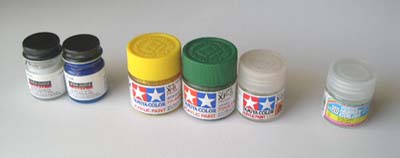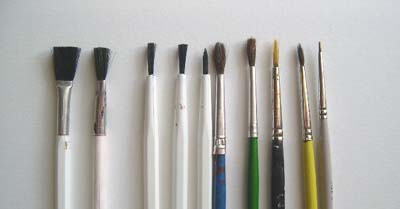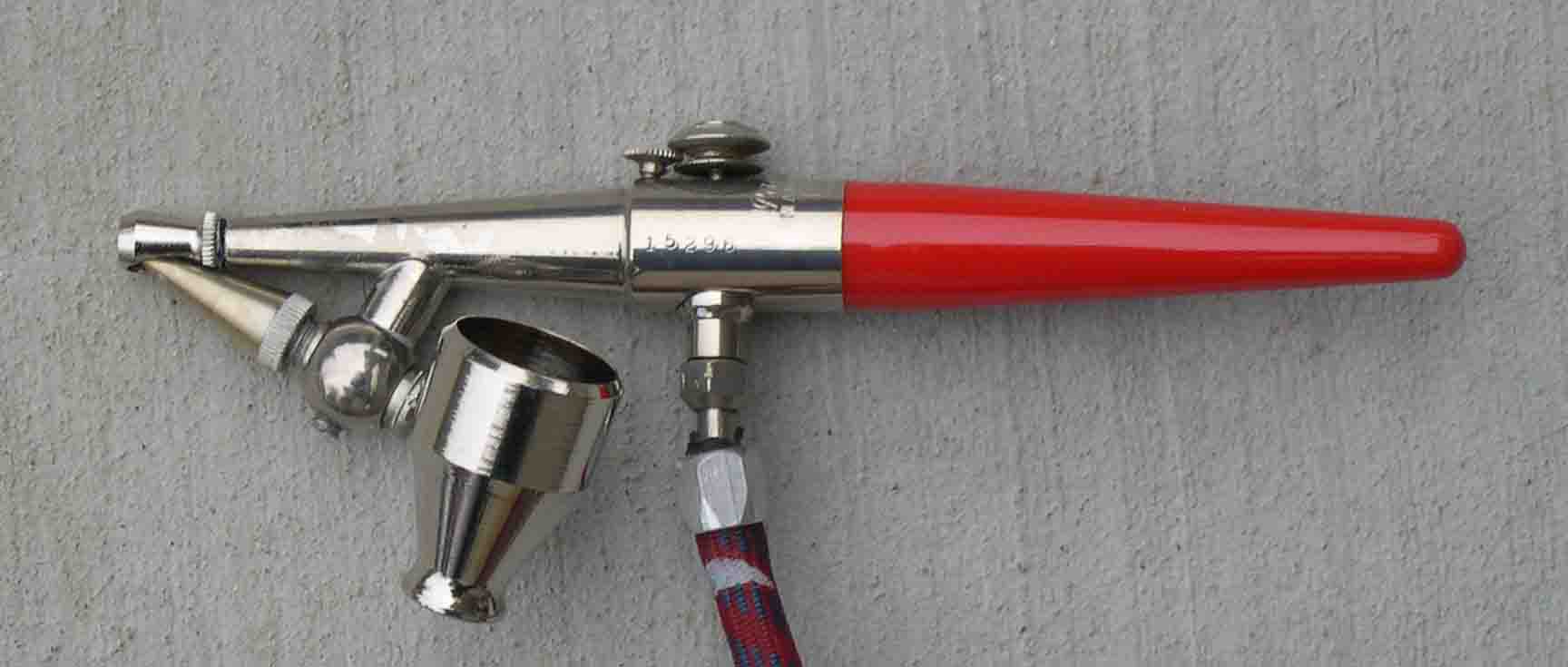Painting
Once the basic structure of the model is completed, it's time to think about painting. The two main decisions facing you are (1) what type of paint to use, and (2) how to apply the paint. After this page, check out our New eBook Learn to Airbrush Model Airplanes.
1) Type of Paint
Every paint has three main components: the pigment which is the color containing part, the resin which binds the pigment to the surface, and the solvent which holds everything together in the liquid form. There are two broad classes of paint, enamels and lacquers. Enamels undergo a chemical reaction (curing) as the solvent evaporates. In lacquers, the solvent evaporates without any curing. Now hobby paints are generally (oil-based) enamels, or aqueous (water-based) acrylic lacquers. The hobby enamels (e.g. Testors, Model Masters, Humbrol) thin with mineral spirits, dry slowly and harden beautifully to a glossy finish. The hobby acrylics (e.g. Tamiya, PollyScale, Floquil, Vallejo) thin with water or alcohol, dry faster, and clean up easier. People tend to develop a preference for one or the other, so try both and see which you prefer.

Above: Assortment of enamel paints.

Above: Assortment of acrylic paints.
2) Applying Paint
There are 3 basic methods for applying the paint to the model: brush painting, spray cans, and airbrush. Each method has its advantages and disadvantages.
Brush
The paintbrush is the simplest method of applying paint. They come in different shapes, flat and round being the most common. They also come in different sizes and materials. You'll need at least: a broad flat brush for large area coverage (1/4 inch or larger), a medium width round brush for general use (#1 or 2), and a fine-point brush for the smallest detail (10/0).

Above: An assortment of model paintbrushes, acquired over time. You can get most models done with three brushes: a wide flat, a medium round, and a fine tip "spotter".
The keys to getting a nice smooth paint job free of brush marks are:
- Minimize overlap of brush strokes. Don't go back and paint over the area you just painted, let the paint level and spread by itself.
- Use a brush with soft bristles, sable is best. For a rough surface (e.g. wall or tire) a camel hair or synthetic brush is fine.
- When painting a wide area, use a wide brush to minimize the number of strokes.
- Make sure the brush is clean.
- Keep dried paint particles and other debris out of your paint bottle. Transferring paint from the bottle to a separate palette or container, using a straw or disposable dropper, helps with this.
- Let the paint dry, then apply a second coat. Don't try to get full thickness in one go.
- Enamels tend to brush better than acrylics as they dry slower. If your acrylic paint is not brushing well, try adding a small amount of thinner, or acrylic paint retarder (from the art supply store). Also, dipping the brush in a container of water helps when brushing acrylics.
- Practice on scrap plastic before painting your first model.
After using the brush, clean up with the recommended thinner. For acrylics, you can use soap and water. Shape the bristles of the brush with your fingers so that they are not distorted. Store with the brushes in a cup-like container with bristles pointing upward and into the air.
Spray Can
The spray paint can is also widely used for model airplanes. It's advantages over brushing include:
- Smoother paint job with no brush strokes.
- Faster than brushing.
- No cleanup of brushes required.
However, paint cans deliver a wide area spray and so are somewhat wasteful. They end up being more expensive. Also, there is generally a limited range of colors available, and custom mixing of paint colors is out of the question. For multiple colors on a model, masking must be done to limit overspray; spraying outside is also a good idea. The cans tend to cool down as they are used, which reduces the paint flow. Placing them in warm water for a few minutes can fix this. Despite their drawbacks, spray cans can very handy, e.g. for single color models. They are very popular for model car bodies. Testors spray enamels and Tamiya spray lacquers are popular choices.
Airbrush
We think that the airbrush is the best tool for painting small scale airplane models. When used with a compressor as the air source, it becomes like an infinite spray can, with the great side benefits of control of the pressure and of the amount of paint. These additional controls can be used to used to create fine lines of paint and many other useful effects.

Above: A single action, external mix, siphon (bottom) feed airbrush, the
Paasche Model H . This airbrush was used to paint the Spitfire and
Corsair models on this website.The airbrush works using Bernoulli's
principle. Air moving at higher velocity has lower pressure. If this air
stream happens to be close to but above some paint, the paint will be drawn
upwards, towards the moving air. When it gets to that stream of air, the paint
gets broken up into fine particles, and is blown in the direction of the
air-stream.
Some basic tips:
- A single action airbrush is simpler, easier to learn, and generally lower cost. It's great for beginners. However, the double action gives you much more control over the paint process.
- A good compressor will be cheaper in the long run than using those cans of compressed air. The compressor will pay for itself after only a few models.
- Use the manufacturer’s recommended thinner. This will keep the paint flowing smoothly without drying too fast.
- To keep the airbrush working smoothly, follow the instructions for cleaning. Improperly cleaned airbrushes are the source of most airbrush issues.
New! our eBook Learn to Airbrush Model Airplanes.
3) Paint Layers
Different types of paint with different purposes are often applied to the same model, in multiple layers. Some of the typical ones are: primer, base coat, color coat, and clear coat.
The primer prepares the surface for the following coats of paint. It tends to bond aggressively with the plastic. The primer is also designed to bond well to the paint, reducing any tendency to peel or lift off (especially) when removing masking tape.
Enamel paint and lacquer sprays bond well enough without without a primer. Some people have reported that acrylics should not be used on bare plastic without a primer. We always wet sand our models with fine sandpaper (then soap and water, blow dry) before the first coat of paint, and have no issues with acrylics. Some people prefer to use an enamel or lacquer spray as primer for acrylics.
There is a special paint known as Alclad 2 which is used to simulate a bare metal airplane finish. This paint is airbrushed onto a surface that has been primed with black paint. Black lacquer paint in a spray can is popular for that purpose. The base coat refers to the main color coat. Sometimes it's painted over with subsequent Color coats (which are just that), e.g. for camouflage.Clear coats are used for a few reasons.
A gloss clear coat provides the best surface for the application of the water slide decals. So if the color coats are flat (matt), and clear gloss coat is applied before the decals. Clear gloss also provides depth and brilliance to a paint job (e.g. auto paint jobs, or airshow airplanes).
The typical World War 2 airplane model should have a flat or semi-sheen surface, just like their full-size counterparts. So after applying decals, a flat clear coat will be required for a realistic look. Wear and tear (weathering) applied with pastel chalks goes best on a flat finish, so a second and final flat clear coat is often applied as the final sealant on the model.
---------------------------------------------------------------------------------------------
Send us your comments below! Login with your Facebook, Twitter, Google or Yahoo account.
